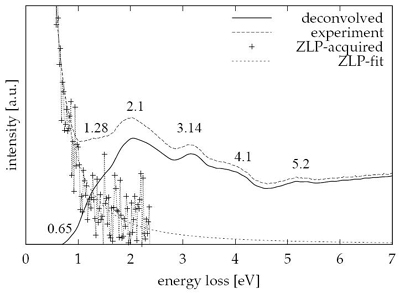Valence Electron Energy Loss Spectrometry (VEELS)
|
VEELS is short for Valence Electron Energy Loss Spectrometry and deals with th low loss part of the energy loss spectrum in the range of 0-50 eV. VEELS is used for detecting bandgaps or for characterizing optical properties of materials. Because of the high operation voltage of a TEM which accelerates the electrons to 0.7 times the speed of light, relativistic effects can be observed in the loss spectrum hampering the determination of bandgaps and optical properties. The theory of VEELS based on Maxwell's theory was described by Erhard Kröger (Zeitschrift für Physik, 216 (1968), S. 115-135), but was forgotten throughout the years. The reason behind could be the bad spatial and energy resolution available experimentally in the late 60s of the 20th century. Todays instruments achieve both, excellent spatial and fantastic energy resolutions. The TEM team of TU Vienna re-described in 2004 these relativistic effects and presented first results at the international EELS workshop EDGE 2005 in Grundlsee, Austria, (Cerenkov losses in valence EELS, M. Stöger-Pollach et. al). Since then retardation losses are a hot topic in EELS research worldwide. At the presence the focus lies on a reduction of the acceleration voltage in order to surpress relativistic effects at all. For this purpose one TEM {link to http://www.ustem.tuwien.ac.at/instrumentation/fei_tecnai_g20/EN/} at TU Vienna (USTEM) can be operated at extremely low beam energies (10-200 kV). This is unique worldwide. |
Low Loss of Silicon
Fig.1: Cerenkov losses in the band gap region |
Contact: M. Stöger-Pollach |


